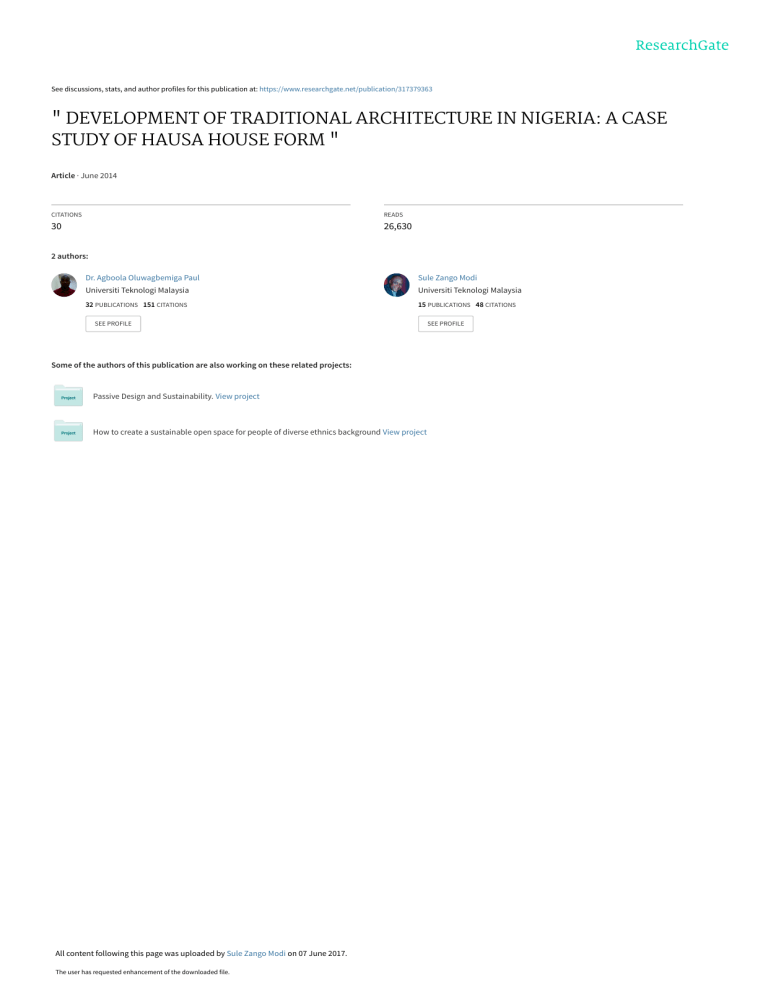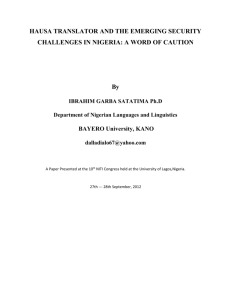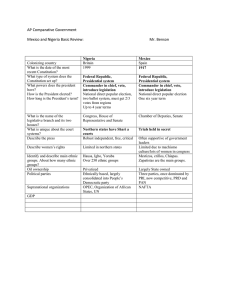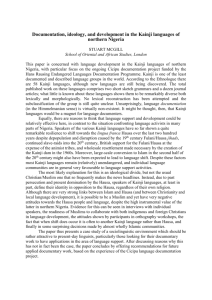
See discussions, stats, and author profiles for this publication at: https://www.researchgate.net/publication/317379363 " DEVELOPMENT OF TRADITIONAL ARCHITECTURE IN NIGERIA: A CASE STUDY OF HAUSA HOUSE FORM " Article · June 2014 CITATIONS READS 30 26,630 2 authors: Dr. Agboola Oluwagbemiga Paul Sule Zango Modi Universiti Teknologi Malaysia Universiti Teknologi Malaysia 32 PUBLICATIONS 151 CITATIONS 15 PUBLICATIONS 48 CITATIONS SEE PROFILE Some of the authors of this publication are also working on these related projects: Passive Design and Sustainability. View project How to create a sustainable open space for people of diverse ethnics background View project All content following this page was uploaded by Sule Zango Modi on 07 June 2017. The user has requested enhancement of the downloaded file. SEE PROFILE International Journal of African Society Cultures and Traditions Vol.1, No.1, pp.61-74, June 2014 Published by European Centre for Research Training and Development UK (www.ea-journals.org) “DEVELOPMENT OF TRADITIONAL ARCHITECTURE IN NIGERIA: A CASE STUDY OF HAUSA HOUSE FORM” Oluwagbemiga Paul Agboola*1 and Modi Sule Zango2 Department of Architecture Faculty of Built Environment Universiti Teknologi Malaysia 81310 UTM, Johor Bahru Malaysia ABSTRACT: Traditional buildings across Nigeria’s geographical zones are known to have demonstrated a thorough response to the climate, local technology and socio-economic milieu in which they evolved. The origin of these different traditional building body associates with the natural materials availability to the local builders as well as religious belief, cultural and taboos. The advent of colonialism in Nigeria changed the traditional life and culture of Nigerian which creates a weak connection between traditional architecture and contemporary architecture in Nigeria. Most recent buildings designs across Hausa regions in Nigeria have been built with imported materials and the construction techniques tailored to satisfy the modernity self-ego and aspirations. Thus, traditional architecture ought not to be abandoned and forgotten, hence; experts’ awareness should be tailored to the understanding of its original essence. This paper through intensive literature review of documents, journals, books, periodical, seminar papers amongst others critically explore the key importance relating to the development of Hausa traditional architecture. In addition, paper identifies the “determinant” and “moderating” factors as main issues that contributed to the development of Hausa traditional architecture, in cognizance of local materials, method of construction, methods layout, social, cultural factors, and environmental factors amongst others. The enumerated factors dominate the colonial periods and the subsequent traditional forms development. Thus, the paper concludes that despite the impact of modernization in terms of styles, materials, and method of construction in recent times, the professionals, designers and the researchers should be cognizance of the social- cultural and religious beliefs of clients/users. It is recommended that, for functional architectural forms, efforts should be geared towards harmonizing the traditional and modern contemporary designs concepts. KEYWORDS: Hausa, Traditional Architecture, Determinant Factors, Moderating Factors, Culture. INTRODUCTION Housing encompasses environment in which man lives and grows in response to both biological material as well as physical needs (Olotuah, 1997a, 1998b). To support this assertion, Massoudi, et.al (1978), buttressed that for a house to perform its optimal goal, it must possess the minimum facilities needed for human health, body and spirit. Housing is a process of creating conditions in which higher portion of man’s life activities occurs therein, Palen, (1987), expatiated. In a related development, the fundamental purposes of housing according 61 International Journal of African Society Cultures and Traditions Vol.1, No.1, pp.61-74, June 2014 Published by European Centre for Research Training and Development UK (www.ea-journals.org) to Mabogunje et. al (1987), are the provision of shelter for the performances of social activities, safety, security, space, privacy, and other purposes that promote good health and dignified living. Nigeria is a country that parades numerous traditional building design concepts at different regions of climatic conditions, socio-economic and cultural background. Rikko & Qwatau (2011), referred to traditional as a cultural heritage gained from generation to generation accepted and practiced by the people. Therefore designs in traditional architecture reflect the cultural lifestyle of the people and represent the symbols of the heritage of the residents. Hence response to the material, spiritual, and social design of the society cannot be over-emphasized (Olotuah, 2001). Consequently, creation of an intimate relationship to the entire system, reinstated the values and customs accepted by residents’ social groups. In addition, the form and functions of housing vary with people customs and culture, as an aftermath of what the populace considered as important in their housing. Rikko & Qwatau (2011) similarly buttressed that different traditional housing forms paraded at different regions of Nigeria are the resultant effects pursuit to comfortable people structures design as influenced by culture, religion, climate, urbanization, and current expertise.. Imaah, (2008), in the same vein noted that building science has proven that wall is witting of thermal and other environmental conditions, therefore, using local builders and building materials, such as tempered clay and timber become inevitable. Fatiregun, (1999), iterated that the environment cum social factors determines the different architectural design solutions that emerged in the pre-colonial traditional setting and emphasized those factors such as climate and available building materials defined the nature of the structures that were evolved. The religion or philosophical learning of each community and their social order together with culture influenced the forms, grouping of buildings as well as the process of their production. Opoko, (2001), enumerates the factors that led to the development of methods as climate, technology, socio-economic and traditional building materials. The author reported that traditional building materials utilization used in a simple but innovative way portrays the reflection of local builder’s expertise. It was concluded that effective building forms have emanated overtime that facilitates the attainment of high level of comfort both within and outside of built environment without recourse to artificial methods. The reliance on modern design techniques and materials has resulted to high cost of construction in recent years. Contrary to this, traditional building materials enable cost effectiveness in terms of materials and simple innovative expertise of the local builders.( Opoko, A.P., 2001). Uji, (1992), opined that aside factors such as social structure, climate, economy, technology, culture and religion that contributed to the development of traditional building methods, other paramount factors comprises of defence, accessibility, physiography and orientation. In recent years, Nigerian Architecture is characterised by the post-modern buildings of the 1990’s and a sprawling new design concept and engrossed with new building materials mainly imported from China. ( Ruquayya Tofa, 2011) reported. The author stated further that the most beautiful circular shapes apparent in Hausa Architecture with its domed roofs, thick monolithic walls and decorative plasters have been replaced by a rectangular concrete prototype with imported roman column replicas. It is insignificantly to structural function rather possessing decorative elements adorning the entrance of the buildings. In spite of the significance benefits associated with traditional architecture in its possession of fairly adaptation to the environment, little efforts have been initiated to explore the characteristics (Ade- Adedokun, 2014). 62 International Journal of African Society Cultures and Traditions Vol.1, No.1, pp.61-74, June 2014 Published by European Centre for Research Training and Development UK (www.ea-journals.org) The question at this juncture is why architects, designers and government policies have frivolously jettisoned the traditional architecture to modern architecture in recent time? Why is little attention focuses on intertwining between modern environment and traditional architecture (cultural heritage), in Nigeria?. In proffering answers these questions, this paper rooted its critical examination of the essence of encouraging the traditional architecture (Hausa house form) with a view to appropriately intimate and enlightens experts in built environment. The professionals such as architects, town planners, builders amongst others should take cognizance of indigenous design theory, technology, craftsmanship and artisanship associated with the advent of traditional building. Thus, recent domination of modern innovations would not be to the detriment of our indigenous expertise. More so, the development of Hausa traditional house forms is known to have demonstrated a thorough understanding and meaningful response, in which the styles not related to individual structures alone but collective neighbourhood design. This paper identified and expatiate the factors that led to the development of Hausa traditional architecture based on two major factors namely, moderating and determinant, which foothold on their power and the influence which associates with roles both play in the development of the design methods. Historical Background of Hausas in Nigeria Nigeria is located at the extreme inner corner of the Gulf of Guinea on the west coast of Africa continent. It occupies an area of 923,768 sq km, extending 1,127 km East- West and 1,046 km North- South as shown in Figure 1 and Figure 2. Meanwhile, Hausas dominates the northern part of the country between latitude 3.50 east to latitude 11.0 east, and from longitude 10.50 north to longitude 14.00 north as shown in Figure 3. Kano in northern Nigeria is the primary centre of Hausas trades and culture. Meanwhile, Hausas covering cities include Kano, Sokoto, Zaria, and Katzina, and they speak Hausa language, which imbedded Arabic language. Figure 1 : Map of Africa continent showing Nigeria. Source: http // : map -of- africa.co.uk Figure 2: Map of Nigeria showing 36 states. Source: Encyclopaedia Britannica Inc. (2011) 63 International Journal of African Society Cultures and Traditions Vol.1, No.1, pp.61-74, June 2014 Published by European Centre for Research Training and Development UK (www.ea-journals.org) HAUSA OCCUPIED REGION Figure 3: Map of Nigeria showing area occupied by Hausas. Source: Chokor B. A.(2005) Also, Hausas occupied the northern plains beyond the Jos plateau, which is a crossroads open not only to Borno state but also to the states of Mali and Songhai in the western Sudan. Hausas according to Britannica (2011) developed numbers of centralised states, such as Daura, Katsina, Kano, Zaria, Gobir and latter Kebbi. In summary, the seven true Hausa states or Hausa Bakwai includes Biram, Daura, Gobir, Katsina, Kano and Zaria (Zazzau). All feudal city-states are housed with a wall, business centre and a monarchical system of government. Islam, which was introduced from the Mali Empire in the 14th century, strengthened both the monarchical impinging. It remained an urban religion until the root of the 19th century. Despite, the walled cities, some pre-Islamic rites stay on part of the ceremonies that maintained monarchical authority. Conquered early in the 19th century by Fulani in whose jihad or “holy war” many Hausa peasants voluntarily combined and were organised into emirates. At the beginning of the 20th century, the British took over the administration of the former emirates, to which they attached Borno to form the Northern provinces (subsequently the northern region) of the protectorates of Nigeria. The earliest Hausa was animists, but Islam plays the dominantly organised religion. The Hausa language is the largest and best –known member of the Chadic subfamily of the Afro-Asiatic family of languages, therefore, Arabic becomes the widely spoken amongst the people. Kano, in northern Nigeria, is considered as the centre of Hausa trade and culture. The Hausa culture reflects a higher degree of specialization and diversification. Thus, their economy has rested on the subsistence agriculture which associates with intensive cultivation of sorghum, corn (maize), millet and many other crops grown on rotation principles utilising the manure of Fulani cattle. Agricultural activity has yielded considerably more than subsistence, permitting the Hausas to practice such craft especially as dyeing, thatching, leather working, weaving and silver smiting. Hausas is renowned itinerant traders trading in leather goods, as well as tourist items. An Overview of Hausa Settlement Pattern Trans-Sahara Trade couple with the new religion of Islam had the most enormous impact on the settlement pattern and local building practices of Hausa land. A simple hierarchy of rural settlement has emerged over the Hausa house form. The compound (Gida) is usually based on the extended family and often sub-divided into sections; each containing family houses and next to Kauye settlement are the composition of several compounds. At the apex of the rural 64 International Journal of African Society Cultures and Traditions Vol.1, No.1, pp.61-74, June 2014 Published by European Centre for Research Training and Development UK (www.ea-journals.org) settlement network is the Gari (town). These historic towns reflect a compact nucleated settlement surrounded with the defensive wall. Historically, the settlement of the Runada (slave settlement) impact on the pattern of rural Zaria layout. This is a replica example in which kind lord devised a settlement scheme that brought the slave labourer in proximity to farm. It was intended to facilitate the cultivation of surrounding farmland, and ensured higher utilization of labour force. Consequent upon which these settlements such as Tabongari have developed into Gari settlement. The urban settlement exists essentially in most Hausa land, which has the tendency to develop city side by side. Usually the long existed and new one began with the development of some policy's pollution of the indigenes by alien, who are non-Muslim couple with developmental services like rail lines. Meanwhile, the condition of security plays a major role in deciding why settlement would be nucleated or dispersed. Typical Zaria is one of the first seven Hausa cities with the best settlement pattern enclosed by ancient protective walls. For example, Kano is a walled city likewise Zaria with its fence walls construction dated back to the 12th century. Also, the concentration of leaders and their families living very close to the market place is an indication of an intention tailored towards effective defensive instinct. This summarizes the development of Hausa's nucleated settlement pattern. EVOLUTION OF HAUSA ARCHITECTURE The categorization is rooted into two groups namely the “determinant factors” and the “moderating factors." Determinant Factors: The following determinant factors associated with the development of Hausa house forms. Hausa Culture: The term “culture” to a social scientist is synonymous to human behaviour and history. Hausa culture encompasses the kinship association and societal structure. Olotuah,(2001), explained culture being a habitual mannerism that is evident in the distinctive characteristics of an individual organising themselves into complex groups focussing on unique functions to create imaginative works of art and architecture. The author opined that the functions of housing thus vary with customs and culture. Religion, lifestyle, mode of dressing, contact with other people are interrelated in culture. Therefore, the behavioural contents of the society described an organised group interacting in a structural system by initiating activities necessary to produce and sustain life. Meanwhile, Olotuah,(2001), identified three major cultural disposition which relates Hausa people as follows: Norms and taboos: Exhibition of Hausa behaviours is strongly influenced by their traditional inheritance in terms of their orientation and views towards initiating final decision over some issues. Ideas, values and religion: Hausa is united by common language and religion of Islam. The introduction of the Islam into Hausa land had an enormous impact on the architecture and building practice, which dictated the use of curvilinear conical and mud dome roof structures as shown in Figure 4 and Figure 5. Also, the ideology of seclusion and privacy for women is 65 International Journal of African Society Cultures and Traditions Vol.1, No.1, pp.61-74, June 2014 Published by European Centre for Research Training and Development UK (www.ea-journals.org) traceable to religion. In the same vein, the separation between the genders responds to Islamic regulation. Thus, dictates the traditional courtyard family compound design. Figure five and Figure six refer. Hausa works and occupation: Most Hausas engaged in ornamentation and agriculture. Ornamentation has played a significant role in their traditional architecture has evident in their craft and dying ability (carving of calabash, making of fabric with different beautiful designs amongst others). Thus affirmed the response to Hausa ornamentation as reflected mostly in their building façade. Reasonable number of Hausas involved in trading and craftsmanship, an indication concretizing the significance of agriculture and culture. Climate: The climate forms part of determinant factors that led to the development of Hausa house form, which include rain, temperature, wind and humidity. Meanwhile, Northern part of the Nigeria hosted by the Hausas and other tribes falls within the savannah area and is characterized by very little rainfall and extreme temperature difference between day and night. Bright sunshine and hot, dry air dominate the daytime, during night associated with extreme cold. Also, climate in this area calls for design solution that can ameliorate the effect of daylight heat and midnight cold. Thus, the structures in these areas where orchestrated to be adequately protected by the introduction of shading devices. Figure 4: Typical Hausa Traditional buildings (curvilinear conical design). Source: Adekeye,O.F: (scholar.google.com/scholar) & Garba, S.B.(2003) Figure 5: Internal appearance of the conical roof. Source: Adekeye, O. F: (google scholar.com/scholar) 66 International Journal of African Society Cultures and Traditions Vol.1, No.1, pp.61-74, June 2014 Published by European Centre for Research Training and Development UK (www.ea-journals.org) Moderating Factors: Several factors associated with transformation (changes) in the development of Hausa house forms have reported by (Olotuah, 2001). These are referred to as the moderating factors as follows: History: History is a factor affecting the transformation of housing over a substantial period. The historical fraction reinstated the settlement pattern and the solution to the inter-tribal wars and security to the residents. Rural settlement pattern in Hausa land emanated from both the past and the present socio-economic, historical and social factors which reflect the changing socioeconomic conditions. Thus, settlement pattern is viewed within the context of the time perspective. Effect of Colonialism: The result of colonial masters brought about an impact on modernization. The impermanent nature of traditional buildings meant that there could be a quick adjustment in the family compound to change circumstances. Relationships vary yearly as there bound to be changes in the number of deaths, births and marriages. Meanwhile, advent of colonial government in Hausa city changed the traditional life and culture of the people. Therefore, Hausa traditional architecture is no longer in vogue; it has been overridden by modern technology and materials. Nevertheless, the economy, political and social virtue have impacted on the traditional architecture thus changed its forms. The dramatic changes witnessed in recent time was brought up by modernization and so manifested in different ways as iterated by Fatiregun,(1999) as follows: The changes caused by the introduction of modern policies and facilities by colonial government yet led to: Abandonment of old traditional settlement and villages for new state settlements and towns Disruption and fragmentation of long standing extended family bonds coupled with increased personal freedom and decreased family sizes. Disappearance of large family compounds and introduction of new smaller nuclear family units. The changes have impacted to Hausa traditional architecture by the introduction of modern materials and technology led to: The change in the physical appearance of settlements the form of different structures. The rejection of traditionally moulded decorations on clay walls for modern paints. The rejection of thatch roof for corrugated iron sheets which resulted to curve-linear forms instead of rectilinear. In a related development, the new religion (Islam) as well as modern education presented by colonials with its laws and written languages, had enormous impacts on the lifestyle of whole Hausa kingdom. 67 International Journal of African Society Cultures and Traditions Vol.1, No.1, pp.61-74, June 2014 Published by European Centre for Research Training and Development UK (www.ea-journals.org) Societal/ Economic Status: Notable chiefs, kings and other important residents in the society in a bid to showcase the level of their affluent often time preferred jettisoning traditional architecture for modern architecture over a substantial period. Material: Evolution of Hausa’s house form based on availability of materials. None of the materials used by traditional architecture was company manufactured, processed or fabricated. Hausas preferred the utilization of useful materials such as vegetation and soil that were readily available in their immediate vicinity. However, the soil in their area is loose and less plastic in nature: therefore, it becomes essential to add grass binders, cow dung, and locust bean pod to the mixture before being moulded to improve the plasticity of the mud. Adeyemi, (2008), adduced this development to the cogent fact that includes cheapness and availability. The traditional building materials proffer greater merit to housing delivery while the demerit of using traditional materials are being solved in areas of ground stabilization in modern construction. ANALYSIS OF ARCHITECTURE OF TRADITIONAL HAUSA DWELLING HOUSE AND METHOD Typical Hausa house is a replica of a building classification under “Sudanese." The associated building form was prevalent and paramount in the West African savannah areas of the Niger and Chad river basin as reiterated by Fatiregun,(1999). Meanwhile, Hausa design associates with courtyard form concepts encircled by numerous rooms that facilitate the expansion to accommodate more inhabitants such as wives and children. Furthermore, the planning concept involves the provision of open air space for injunction. Islamic design principle required seclusion and privacy for women. In this regard, Hausa compounds were divided into two areas namely: the front area or the “Zaure," which belong to the master of the house and the latter part beyond the “Zaure” provided as women quarters arranged around a courtyard as shown in the Figure 6 and Figure7. In compliance with Islamic injunction women in purdah are secluded from the outer male reception area. “ZAURE ” Figure 6: Typical Hausa traditional courtyard house plan: Source: Rowan, 1981 68 International Journal of African Society Cultures and Traditions Vol.1, No.1, pp.61-74, June 2014 Published by European Centre for Research Training and Development UK (www.ea-journals.org) Figure 7: Typical traditional Hausa house plan. Source: Adeyemi, (2008) Osasona, (2007), asserted that “Zaure” happens to be a multi-purpose space that symbolizes social- religious unit within the Hausa building, defining the level of social acceptance. Notwithstanding, only male counterpart that is respected and dignified is allowed to move beyond this zone. The “Zaure” major function as emphasized by Adamu, (2005), includes reception, security, protection, privacy, moral, ethnic ideas, decorations and administration. Moreover, the provision of fairly large spaces at the vicinity of the neighbourhood necessitates congregational assembly to celebrate social functions such as a naming ceremony, wedding ceremony, and playground for children and so forth. The indigenous materials for construction in Hausa land involve four major materials namely: earth, timber, reeds, grasses, and stones (Moughtin, 1985), (Dmochowski, 1990). The construction involved pear-shaped sun dried mud bricks that are moulded from the red laterite soil (Jankasa) found around the neighbourhood. The laterite soil has high fibre content, when skilfully mould, produces excellent materials for buildings’ walls and roofs. Also, moulding the mud walls bricks involves mixing the laterite soil with water thoroughly. When properly dried are then laid in regular courses with points facing upwards (“Tubali” method of construction). Egg-shaped units of Adobe (“Tubali”) which has been earth-plastered, are put together to create buildings given a monolithic appearance (Osasona, 2007) buttressed. In the construction, the roofs structures in this zone are formed with small door space with little or no window openings which are usually achieved with the intention to eliminate the hot, dry and dusty air. The prevention is also applicable to bright daylight and entry of air at night. Similarly, the location and small size of the window helps in curtailing the incursion of dust and flies. The construction of mud roofs involves split palm frond pieces which are laid on palm frond beams in herringbone fashion and plastered on both sides with mud. Plastering of the walls is made with mud containing a mixture of potash or juice derived from the locust bean. Meanwhile, the wide use of flat or vaulted mud roofs in Hausa land indicates method of forestalling the risks of urban fire prevention, therefore, the formulation of policies proscribing the use of thatched roofs within the urban metropolis. This policy started the remarkable disparity between urban and rural architecture in Hausa land. Consequently, while the 69 International Journal of African Society Cultures and Traditions Vol.1, No.1, pp.61-74, June 2014 Published by European Centre for Research Training and Development UK (www.ea-journals.org) structures in urban areas had mud roofs and rectangular walls, the ones in sub-urban areas had simple thatch roofs over circular planes. Meanwhile, the wide use of mud roofs respond to extreme temperature differences between days and nights, because they are semi-conductors that maintain temperature equilibrium, as well as buffer between interiors and exteriors environments. The introduction of new building materials such as cement and corrugated iron sheet from Europe had the tremendous impact on the physical appearance and body. For instance, corrugated iron sheets quickly gained wide acceptance, hence the abandonment of traditional thatch roofs which were highly inflammable. In addition, since it is very difficult to roof circular structure with rectangular iron sheets, this form the basis in some areas where basic shape of their structure changed to rectangular one. Adamu, (2005), categorized decoration in Hausa traditional architecture into three groups namely, surface design, calligraphy and ornamental. The author observed that the three categories could be displayed on a single facade of the “Zaure," although the choice depends on the status and preference of the users. “Graffito” is the term given to a form of decoration in which different colour wall plasters are laid in layers, and the design is made by scratching away the upper layers. Denyer, (1978), pointed out that this decoration may imbue some magical or religious significant. The Hausa practiced this form of “Graffito” on, which decorative patterns are scratched into smooth wall patterns resulted from texturing the interstices of the decorative layout by roughing it with a piece of metal. Hausas decorates their street facade with intricate interlacing arabesque relief forms painted in rich colours. Hence, street facade decoration is usually a demonstration of wealth and social prestige amongst Hausa as indicated in Figure 8 and Figure 9. Figure 8: External mural painting on the facade of Hausa buildings. Source Adekeye O.F.(Goggle scholar.com) & Garba S. B. (2003) 70 International Journal of African Society Cultures and Traditions Vol.1, No.1, pp.61-74, June 2014 Published by European Centre for Research Training and Development UK (www.ea-journals.org) Figure 9: Interior gate of Emir of Kano's Palace showing mural painting on the facade of the wall. Source: Abdullahi, A. (2009) Another feature of Hausa facade decorations are the horns of mud (Zanko) shown along the parapet of their buildings, which gives Hausa structure a lighter and picturesque appearance. Figure 10 and Figure 11 Figure 10: Entrance of Hausa building showing "Zanko” and Mural decoration. Source: Adeyemi, (2008) & Garba S.B. (2003) 71 International Journal of African Society Cultures and Traditions Vol.1, No.1, pp.61-74, June 2014 Published by European Centre for Research Training and Development UK (www.ea-journals.org) Figure 11: Entrance of Hausa building showing “Zanko” Source: Adeyemi, (2008) & Garba S.B.(2003) CONTRIBUTION TO KNOWLEDGE, RECOMMENDATION AND CONCLUSION This paper, therefore, will be beneficial to designers, architects and other allied professionals in the built environment, reinstating the essence to integrate traditional form, ideas, expressions, materials into their modern/ recent designs and techniques. Creation of a new vernacular approach enhances the resultant interplay between the modern and traditional design concepts cum materials utilization. This paper recommends that Architects’ interest should focus on traditional design vis-avis modern concepts and expertise. Through this, the utilization of cheaper building materials such as earth, wood, stone and thatch and the design principles of privacy, space, comfort rooted in the Nigerian Traditional Architecture would be enhanced. In conclusion, this paper had critically examined the numerous factors that contributed to the development of Hausa traditional architecture of the Northern part of Nigeria. The tremendous impact of modernization is commendable and cannot be underrated, better still; this paper advocates the importance of cross-blending the modern concept and traditional concept. Thus, experts are advised not jettison our traditional inheritance expertise associated with design evolvement and execution. It will be a great tragedy and a colossal loss if our traditional building styles and construction process disappear from the continent. The benefits derived from our indigenous methods and materials were enormous and needed to be propagated, while any inadequacy associated with the traditional approach could be modified. REFERENCES Abdullahi, A. (2009): Architecture: The Concourse Of Art, Science, Technology, Nature And Politics. Techno Science Africana Journal. Vol. 3 No.1, P 7 Adamu M.S.T. (2005): “Interpretation of significant and messages in Hausa traditional architecture. Case of the “Zaure” entrance hall. Journal of the Association of Architectural Educators in Nigeria.Vol.4, No 1. January- March, 2005. Pp10-21. 72 International Journal of African Society Cultures and Traditions Vol.1, No.1, pp.61-74, June 2014 Published by European Centre for Research Training and Development UK (www.ea-journals.org) Ade-Adedokun (2014): Environmental and Adaptation in Architecture planning and Building Design; Lesson from the Forest region of West Africa. British Journal of Environmental Sciences. Vol. 2. Issue 1. Pp9-20. Adekeye, O. F: The Influence of Modern Architecture on Ilorin Traditional Buildings in Kwara State. scholar.google.com/scholar?q=Olutola+Funmilayo+Adekeye&btnG=&hl=en&as_sdt= 0%2C5. Retrieved today, 23rd March, 2014. Adeyemi, E. A. (2008): Meaning and Relevance in Nigerian Traditional Architecture: the Dialectics of Growth and Change. Public Lecture Series one. (21), pp 1-33. Chokor Boyowa A. (2005): Changing urban housing form and organization in Nigeria: lessons for community planning, Planning Perspectives, vol.20, no.1,pp 69-96. Denyer, S. (1978): African traditional architecture, London. Heinemann Publishers. Pp 164165. Dmochowski, Z. R., ( 1990): An Introduction to Nigerian Architecture - Northern Nigeria, Ethnographical Ltd. London, 1990, Pp: 1-20. Fatiregun, A.A. (1999): “A brief history of traditional African architecture (with 50 illustrations), Ilesa, Fatiregun press Ltd. Pp 11-37. Garba Shaibu Bala (2003): Images of tradition and modernity. http://faculty.kfupm.edu.sa/ARCH/sbgarba/Research/NIGERIAN_PRESENTATION. PPT Retrieved on 3rd April, 2014. Hausa state, (2011): Encyclopaedia Britannica. Ultimate Reference Suite. Chicago. Britannica. (www.britannica.com/Ebchecked/topic/257110/Hausa-state.). Retrieved on 3rd April, 2014. Imaah, N. O. (2008): “The Natural and Human environments in Nigeria: Their Implications for Architecture." Journal of Applied Sciences and Environmental Management." Vol.12, No2. Pp73. Information pages: “Nigeria in the beginning”(nd). http:/www.rid1ontheweb.blogspot.com/2009/07/Nigeria-in-beginning.html_ is. rd Retrieved on 3 April, 2014. Mabogunje, A. L., Hardoy, J. E., Misra P.R. (1978): “Shelter provision in developing countries, The Gresham Press. http://scindeks.ceon.rs/article..aspx?artid=1450-569x07160281_br. Massoudi, A. &Simonian W. (1978 ): “The problem of Housing in development countries." In Housing Problem, in Developing countries, Dakhil, H. et. al (Eds). Pp 175-194. Material and form: “Form Follow Material”?. Springer n.d.Retrieved from htt://links.springer.com/chapter/8/10./007/978-3-7643-8282-2-2br. 5th April, 2014. Microsoft Encarta (2005): “Encyclopaedia of Microsoft Corporation. Moughtin, J.C.(1985): Hausa Architecture. Ethnographical Ltd. London. Pp 1-123. Olotuah, A. O. (2001): “Mass Housing Design." Unpublished course monograph for Postgraduate Diploma students in architecture. Department of Architecture, the Federal university of technology, Akure. Pp. 2-9. Olotuah, A.O.(1997a): “The house: Accessibility and development- A critical evaluation of the Nigerian situation." In the House in Nigeria.” Proceedings of the National Symposium 23rd -24th July, Obafemi Awolowo University, Ile- Ife. Pp. 312-317. Olotuah, A.O. (1998b): “Housing: The Intractable Human Imperative, Nigeria’s urban situation."Unpublished Monographs. Forthcoming in Housing is today. Osasona, C. O. (2007): From traditional residential architecture to the vernacular: the Nigerian experience. Online http: www. mainline. Org/aat/2007_documents/AAT_Osasona, 1719. 73 International Journal of African Society Cultures and Traditions Vol.1, No.1, pp.61-74, June 2014 Published by European Centre for Research Training and Development UK (www.ea-journals.org) Opoko, A. P. (2001): “Low energy features of traditional buildings in the Hot-Dry Climatic zones of Nigeria: In Nigerian Institute of Architects Journal. Vol. 2, No 8-12, November, 2001.Pp 29-300. Rikko L.S, and Gwatau, D. (2011): The Nigerian architecture: The trend in housing development. Journal of Geography and Regional Planning. Vol. 4(5), pp. 273-278. Available online at : http://www.academicjournals.org/JGRP.ISSN 2070-1845 ©2010 Academic Journals. Rowan, R.K. (1981): “Formal and spatial variations in a traditional walled city Zaria, Nigeria. Unpublished thesis, submitted in partial fulfilment of the requirement for the degree of Master of Architecture at the Massachusetts Institute of Technology. Ruqayya B. Tofa (2011): Traditional Nigerian Architecture And Design. Presentation for INTBAU and TAG Event, UK. 9-10th, February 2011. Uji, Z. (1992): “Commonality in the House forms of the Nigerian cultures in change." Journal of Nigerian Institute of Architects.” January- April, Pp. 26-31. 74 View publication stats






